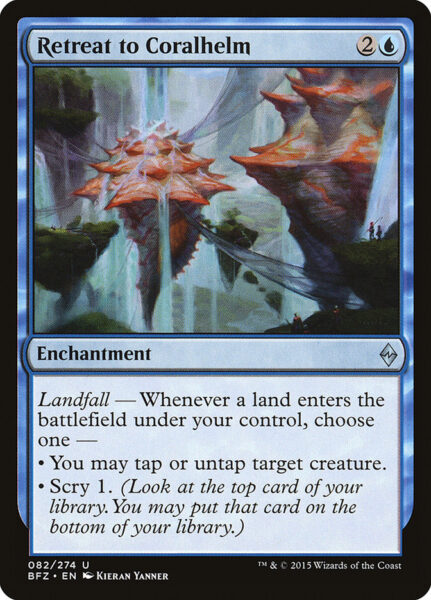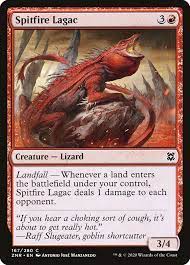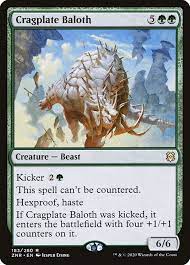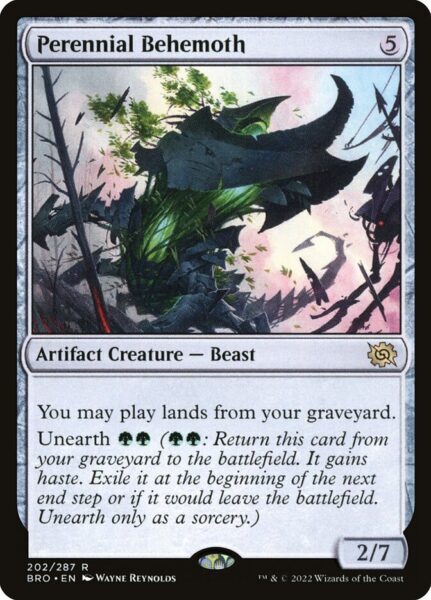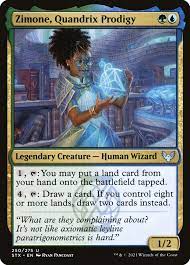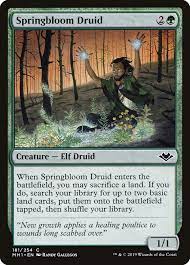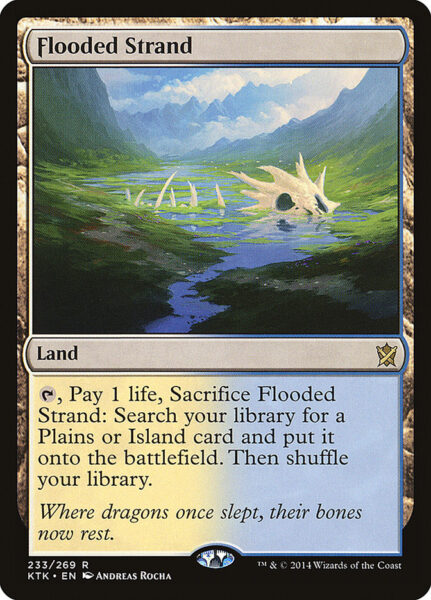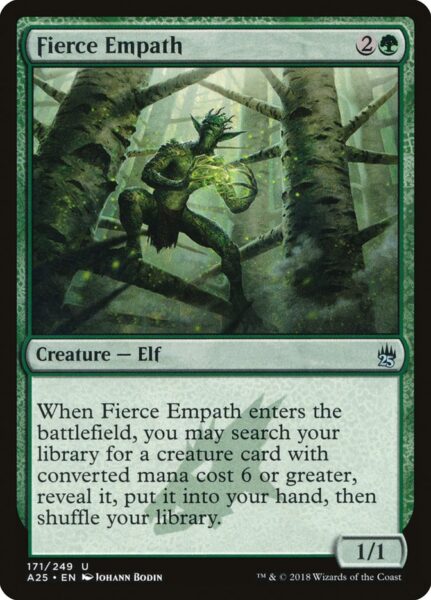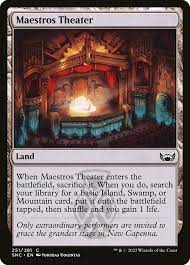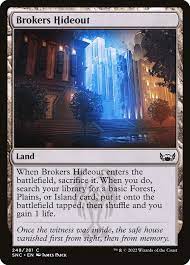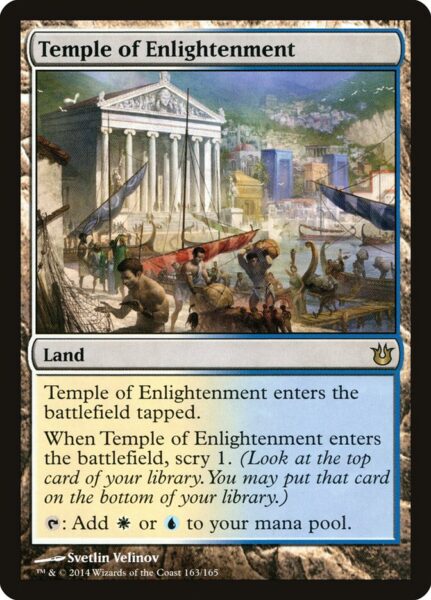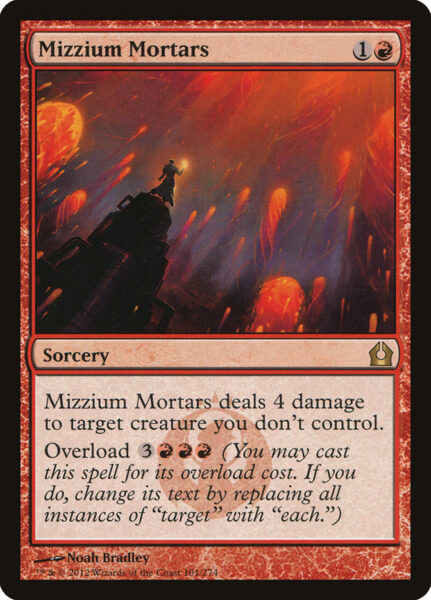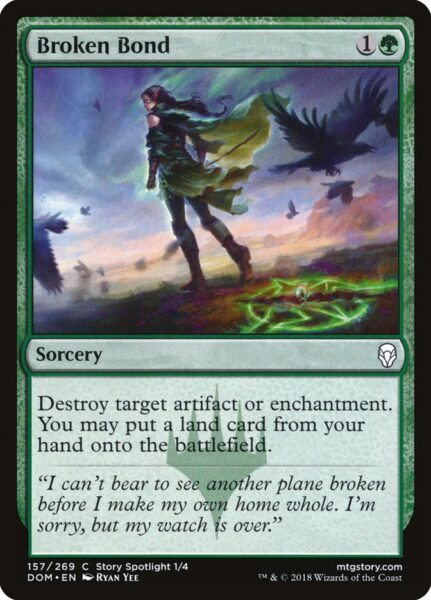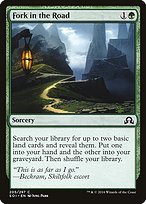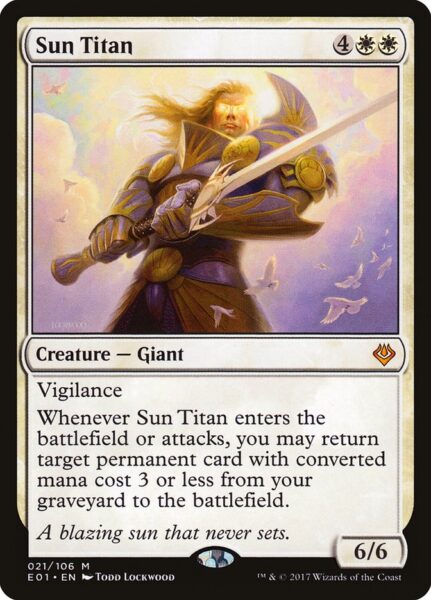by Johnny Cycles, November 30th, 2023

Welcome to my first Budget Commander article! And what better way to start this series off then with one of the most busted commanders I’ve written about so far? Not to mention, a commander that breaks our budget of $1 a card. But hey, spending a little extra on a commander is reasonable, right? Omnath, Locus of Creation will set you back about $11, which is a lot for a piece of cardboard, particularly when you’re on a budget. However, my ultimate goal is to keep each deck in this series less than $100 and I’m confident we’ll stay under budget, even with a pricey commander at the helm.
Decklist – Budget 4-Color Landfall Combo with Omnath, Locus of Creation
| Omnath, Locus of Creation |
Creatures (31) + 2 mfdcs
| Oran-Rief Hydra | |
| Phabine, Boss’s Confidant | |
| Phylath, World Sculptor | |
| Rampaging Baloths | |
| Cragplate Baloth |
| Pearl Lake Ancient | |
| Plated Crusher | |
| Simic Sky Swallower | |
| End-Raze Forerunners |
Artifacts (1)
| Seer’s Sundial |
Enchantments (7)
| Impact Tremors | |
| Roar of Resistance | |
| Fires of Yavimaya | |
| Oblivion Ring | |
| Retreat to Coralhelm | |
| Valakut Exploration | |
| Retreat to Emeria |
Instants (7)
| Abrade | |
| Disdainful Stroke | |
| Growth Spiral | |
| Oblation | |
| Roiling Regrowth | |
| Dismiss | |
| Eureka Moment |
Sorceries (14) + 1 mfdc
| Reclaim the Wastes | |
| Explore | |
| Mizzium Mortars | |
| Far Wanderings | |
| Grow from the Ashes | |
| Scale the Heights | |
| Sylvan Awakening | |
| Explosive Vegetation | |
| Migration Path | |
| Splendid Reclamation |
| Vastwood Surge | |
| Burn at the Stake | |
| Echoing Equation (mfdc) | |
| Overrun | |
| Tromp the Domains |
Lands (40) + 1 mfdc
Azorius Chancery
Blighted Woodland
Boros Garrison
Botanical Plaza
Brokers Hideout
Cabaretti Courtyard
Evolving Wilds
Gruul Turf
Izzet Boilerworks
Kazandu Valley (mfdc)
Maestros Theater
Myriad Landscape
Obscura Storefront
Promising Vein
Racers’ Ring
Riveteers Overlook
Selesnya Sanctuary
Simic Growth Chamber
Skybridge Towers
Temple of Abandon
Temple of Enlightenment
Temple of Epiphany
Temple of Mystery
Temple of Plenty
Temple of Triumph
Terramorphic Expanse
Forest (5)
Island (2)
Mountain (3)
Plains (4)
There’s something so in tune with the spirit of Commander to build a deck with budgetary limitations. After all, at the heart of Commander is finding and playing cards that otherwise don’t see play in constructed formats. And I don’t mean just playing a pile of bad cards. No, Commander gives us the space to play forgotten cards in a way that shows off their power, their synergies, and their fun. Anyone can take the most powerful cards, regardless of synergy, and build a competitive deck. The fun and challenge of Commander, and more so with arbitrary deck-building restrictions in place, is finding hidden gems that shine specifically in support of a given commander or strategy.
These two cards are basically the same, right?
Limiting our card choices to under $1 forces us to dig even deeper for the rarely played card. Yes, this means we are much less likely to play the most optimal cards, but it also means we get to play many more pet cards, flavor-win cards, and simply fun cards. For each missing Counterspell (averages well over a $1), we get to play Dismiss (hey, it’s almost Cryptic Command, right?). For each Swords to Plowshares (yup, also averages more than $1), we get to play Oblation and Rapid Hybridization.
On the other side of this coin, we are also pleasantly surprised when we discover a powerful card that is somehow under $1. Yasharn, Implacable Earth, Phylath, World Sculptor, and Rampaging Baloths are examples of cards I was stunned to find were so cheap. Some of these cards have been reprinted a bunch of times, while others are simply the victim of power creep. Either way, Budget Commander – even with choosing cards less than $1 – has fertile soil for deckbuilding and many powerful options.
Why Omnath, Locus of Creation?
There are many reasons Omnath, Locus of Creation is a powerful choice for Budget Commander (I’ve already detailed the power of the non-budget version of this deck). First, landfall as a mechanic has been around for more than a decade now and has appeared in multiple sets. This widens our possible payoff cards, as Wizards has not only reprinted some of the first cards with landfall many times (Rampaging Baloths), they have also designed new landfall cards across the rarity spectrum.
Second, there are certain kinds of effects or spells that Wizards keeps reprinting with different names. The relevant spell for us is 4 mana to search up 2 basic land cards and put them on the battlefield tapped. This variety increases our chances of achieving a critical mass of this effect that will trigger Omnath, Locus of Creation multiple times in a turn.
Third, Magic has no shortage of bombs. Older cards, like Drowner of Hope or Simic Sky Swallower, have largely been outclassed in recent years as power creep continues its inexorable charge forward. However, simply because better and cheaper (mana cost-wise) bombs exist does not mean older and cheaper (money-wise) bombs are not powerful or game-ending.
These budget fetch lands are game changers for our deck.
Fourth, and perhaps most crucially, the recent printing of a new cycle of fetch lands in Streets of New Capenna has given us an essential and previously missing piece of the deck: a land that can trigger Omnath, Locus of Creation twice, which is the magic number, by itself and with no further mana investment or having to take a whole turn off before cracking them.
Finally, Omnath, Locus of Creation, even on a budget, is an extremely powerful commander that allows us to build a super fun combo deck that has synergies and explosive turns. And while our power level is not on par with the non-budget version’s exactly, Omnath, Locus of Creation does show off the potential of budget decks in Commander. Having fun and winning games is not linked solely to spending a lot of money.
Primary Game Plan
Similar to our non-budget Omnath, Locus of Creation deck, we want to make multiple land drops in a turn in order to trigger landfall as many times as possible. We play 13 total landfall cards, which is great, given our $$ restrictions. We even still have the infinite combo of Retreat to Coralhelm, Llanowar Scout, and a bounce land (Gruul Turf) to make infinite land drops and win the game in at least 6 different ways! We can mill our opponent out, burn our opponent out in more than one manner, or make infinite tokens and attack. That’s not too shabby for a budget deck!
Unlike our non-budget deck, however, we lack access to the best tutors in the game. This, in turn, decreases the likelihood of us assembling a game-winning combo. We have to draw into it naturally. A real consequence of this is we have more low-impact draws, such as Ruin Crab or Impact Tremors, that are at their best in combination with specific other cards that we may not have at the time. This is the risk any combo deck runs, but without ways to tutor up our missing pieces, or the budget to play redundant cards, we will be left with some weak, if not dead, draws.
Because of this, we are looking to steadily gain incremental advantage over the course of the game. We have the capacity to make at least 2 land drops a turn pretty consistently. With one or two landfall cards on the battlefield, this can help us pull away or set up for a big turn. If we have one of our pingers or token producers, we can chip in some early damage to soften up our opponent for a big attack later. If, instead, we have one of our finishers out that has landfall, a couple of turns of multiple land drops will often be enough to get us there.
Short of our infinite combo, we won’t really have a single turn where we go off and win, as with the non-budget version. More likely is we take a few turns to build up a bigger board than our opponents and win through combat with the help of an Overrun effect. Until then, we want to leverage the extra mana we get from Omnath, Locus of Creation to play more than one spell a turn or get down a big finisher sooner than our opponent.
Infinite Land-Drop Combo
I discuss this combo here, but I will take a moment to detail it now, as I’ll reference it throughout the article. Llanowar Scout, Retreat to Coralhelm, and a bounce land (Gruul Turf, Azorius Chancery, etc.), allow us to make infinite land drops. Here’s how it works. We tap Llanowar Scout to put a bounce land into play, which triggers Retreat to Coralhelm, which we use to untap Llanowar Scout. We then target the bounce land with its ETB trigger, return it to hand, and start the process over. This 3-card combo doesn’t do anything for us unless we have a landfall card on the battlefield. With one of these out, we suddenly have an alternate win condition.
Win Conditions Using our Infinite Combo
Ruin Crab – we mill each opponent out.
Spitfire Lagac – we burn each opponent out.
Valakut Exploration – we exile enough cards to burn our opponent out at our end step.
Honorable Mention:
Kazandu Nectarpot – we gain infinite life.
We have a few more win conditions using this combo that require more than a single landfall card.
Burn at the Stake + Retreat to Emeria, Sporemound, or Rampaging Baloths – we burn our opponent out.
Impact Tremors + Retreat to Emeria, Sporemound, or Rampaging Baloths – we burn our opponent out.
Haste + Retreat to Emeria, Sporemound, or Rampaging Baloths – we make an infinite number of dorks and attack. We have three ways to give our tokens haste: Roar of Resistance, Fires of Yavimaya, and Phabine, Boss’s Confidant.
Trample + Retreat to Emeria – we put an infinite number of counters on 1 of our 5 creatures with trample – Augmenter Pugilist, Rampaging Baloths, Oran-Rief Hydra, End-Raze Forerunners, and Plated Crusher – and swing out. Note, however, that we don’t even need Retreat to Emeria if we have Oran-Rief Hydra on the battlefield.
Haste + Trample + Retreat to Emeria – make an infinite number of 1/1 Kor Ally tokens, grow them an infinite amount, cast End-Raze Forerunners, then attack. Yeah, that seems like the best option.
Landfall Cards
We play 13 cards with landfall, including our commander. These are some of our most powerful cards and are key to many of our alternate win conditions. Others constitute our big finishers. And while we don’t have the ability to consistently make more than 3 land drops a turn, as in our non-budget version, we are looking to gain incremental value out of these cards. This value will either allow us to slowly pull ahead to victory, or set us up for a big combo win, as I will discuss.
Kazandu Mammoth – probably our worst landfall payoff, if we get it down on turn 3 and follow it up with a fetch land, we can swing in for 7 on turn 4. Yeah, it’s in the deck primarily because it’s a land on the back.
Kazandu Nectarpot – incremental lifegain can help keep us alive long enough to leverage our various synergies to victory. Infinite life keeps us safe from all but commander damage.
Omnath, Locus of Creation – the centerpiece of our deck, we really want to trigger Omnath twice as often as possible. The 4 extra mana we get from this is key to us pulling ahead of our opponent by doing more than 1 thing a turn before them.
Oran-Rief Hydra – trample is what Kazandu Mammoth needs to be good. This is one of our must-answer threats, as it can quickly grow huge and chump blocking is off the table.
Phylath, World Sculptor – this card is very powerful and has only recently dropped below $1. We play 14 basic lands, with most of our fetches limited to finding basics only. Making at least 4 Plant tokens with this Elemental should be baseline. If left unchecked, it will grow us a massive army. The token generation combos nicely with Tromp the Domains. The synergies! And on a budget!
Rampaging Baloths – another finisher, it’s hard to believe this card is under $1 when it was first printed as a mythic rare. Trample makes it a powerful threat, but we really want to make a bunch of 4/4 Beast tokens followed up by Overrun.
Retreat to Coralhelm – one piece of our infinite combo, its other mode lets us dig for what we need, say, like the other pieces of said combo.
Retreat to Emeria – early, this enchantment can help keep us alive with chump blockers, while late it can be a worse Overrun with just 3 land drops. Don’t underestimate its tempo potential with the right board state. Giving our various creatures +2/+2 for several turns can seriously pressure our opponent.
Ruin Crab – Hedron Crab’s younger, and budget-friendly, brother, each land mills each opponent, which is a plus in our deck. It is unlikely we’ll mill our opponent out without assembling our infinite land-drop combo, but it’s always possible. At the very least, we’ll annoy our opponent. At worst, we’ll fuel their graveyard shenanigans. Based on their commander, we should know if milling them is a good idea or if we should keep the crab in our hand.
Seer’s Sundial – a second land drop with this artifact and Omnath, Locus of Creation out and we’ll draw 2 cards and still be ahead on mana. Now that’s value!
Spitfire Lagac – each land drop pings each opponent for 1. As with Ruin Crab, we can win the game with this Lizard on the battlefield if we have our infinite combo out. Otherwise, we can chip in a fair amount of damage over the course of the game and hopefully make combat more favorable for us by forcing bad blocks.
Sporemound – for 1 mana less than Rampaging Baloths, we get a 3/3 vanilla creature that makes 1/1 Saproling tokens. It synergizes with several of our alternate win conditions, while the token generation is not insignificant for all the same reasons it’s not for cards like Retreat to Emeria.
Valakut Exploration – a conditional source of card advantage, the second block of text gives us a way to burn our opponent out.
Finishers
These are the big fatties we want to play to close out games. Most differ from the cards we discussed as part of our infinite combo as they won’t win us the game with infinite land drops. Instead, these are hard-to-deal-with threats that hit hard and can finish off our opponent through combat. Like with any non-budget deck, however, I’ve chosen cards that synergize with other parts of our deck, not just the biggest and baddest finishers I could find for under $1.
Augmenter Pugilist – with 8 or more lands, this trampling 3-drop becomes an 8/8.
Burn at the Stake – okay, so this is a card we can win with with our infinite combo, but I’m including it (and a few other such cards) here, because we can win with it without our combo. We have a lot of ways of making tokens that we can use to burn our opponent out. It is also one of my pet cards that I try to make work whenever possible, usually without much success. As a plus, it can target creatures, in case something really needs to die.
Cragplate Baloth – a hard-to-deal-with threat with haste that comes down either as a 6/6 or a 10/10. The only thing that would make this card better is if it had trample. That it doesn’t is probably why it’s under a $1.
Drowner of Hope – who needs trample when you can tap your opponent’s creatures? The 5/5 body for 6 is pretty meh, but the two tokens it makes synergizes with other parts of our deck, like…
End-Raze Forerunners – those Eldrazi Scion tokens from Drowner of Hope can get buffed and help Overrun our opponent with this 8-drop. It’s outclassed by its much more expensive big brother, Craterhoof Behemoth, but since it was printed in a promo pack and Commander deck, it’s under $1.
Oran-Rief Hydra – a trampling threat we can grow large, fast.
Overrun – giving our team +3/+3 and trample will often be game over. Another payoff for all our token generating.
Pearl Lake Ancient – that’s a lot of text for a card that sells for less than a $1. And it’s only had a single printing. Its lack of evasion and better control finishers in Blue are probably why it’s budget friendly. What we really care about, though, is the last line of text: we get to return lands to our hand (to keep it alive). Readers of my non-budget Omnath article know how important having lands in hand to trigger our landfall cards is. Well, this Leviathan gives us 3. Thank you very much!
Plated Crusher – hexproof and trample make this card worth including. 7 mana is a lot, but we are on a budget.
Phylath, World Sculptor – the tokens it makes synergize with our Overrun effects. That it can then grow them itself is a long-term plan of victory, but can give us a small, but very powerful army.
Rampaging Baloths – more token generation, this time 4/4s. If you haven’t noticed the trend yet, one of our primary ways of winning through combat is to make a lot of dorks and cast an Overrun effect.
Simic Sky Swallower – a card that would probably cost at least one less mana if it were first printed today, it has both flying, trample, and shroud, which means it’s a great finisher…on a budget.
Sylvan Awakening – a way to turn all of our lands into potentially lethal threats for a turn. Note, too, that the effect is until our next turn, meaning we can hold them back for blocking if necessary.
Tromp the Domains – we should almost always cast this for full value, giving our team +4/+4 and trample. Works great with Sylvan Awakening, assuming we have enough mana.
Playing All the Lands
Just like with our non-budget Omnath deck, we want to maximize our ways of making more than one land drop a turn. And, even on a budget, we have a variety of methods to ensure we can play an extra land every turn. They can be divided into the following three categories: 1. cards that let us play more than one land in a turn from our hand; 2. cards that search up more than one land and put them directly onto the battlefield from our library; and 3. cards that let us play lands from the top of our library or graveyard.
More than One Land Drop a Turn
These are the cards that allow us to play an extra land from hand, either as part of the spell, or as an activated ability that comes, usually, with a mana investment. These cards are great at ensuring we make at least 2 land drops in a turn, as long as we don’t run out of lands in our hand (more on this later).
Unfortunately, many of the best cards that give us the ability to literally make multiple land drops in a turn without further mana investment, like Azusa, Lost but Seeking, Oracle of Mul Daya, and Dryad of the Ilysian Grove, are outside of our $1 budget. The former two are both down under $6, which feels almost miraculous, given how expensive they were just a few years ago. The latter’s price is largely due to Modern.
We can dream…
That being said, we do get one card that helps us greatly: Mina and Denn, Wildborn. More fun, though, is we get to play a bunch of sweet and different cards that just don’t make the cut in the non-budget version, but which are still powerful options.
Explore – a 1-time extra land drop that also draws us a card. For those of you new to Magic, this kind of 2-drop can let us keep a 2-land 7 rather than mulliganing. For those of you who’ve been playing Magic for awhile, you know there’s no guarantee we still won’t get burned and miss our 3rd land drop. We really want to cast Explore on turn 2 only when we have at least one other land in hand to play.
Gretchen Titchwillow – for as many times as we have , we get to draw a card and put a land into play. Know which card we play that gives us for our 2nd land drop? This is one of our spicy, fun cards that support our deck’s synergies.
Growth Spiral – an Explore at instant speed.
Llanowar Scout – part of our infinite combo, this Elf Scout can also guarantee us a 2nd land drop to trigger Omnath, Locus of Creation.
Murasa Rootgrazer – another spicy 2-drop I’m super excited to play. This Beast almost made the cut for the non-budget version since it can return a land we control to our hand to ensure we always have at least one land drop to make each turn.
Scaled Herbalist – someone at Wizards decided we needed another Llanowar Scout, but instead of making this one an Elf, they decided to make it a Lizard Druid. Whatevs…redundancy is great for any combo deck!
Zimone, Quandrix Prodigy – a late-game card draw engine that also lets us make an extra land drop each turn. Yes, please!

Scale the Heights – this card is an example of both the power creep given to Green and how Wizards is willing to break the color pie. Playing an additional land is something Green does. Lifegain, however, is primarily given to White, while card draw is the realm of Blue. Oh, and we get to put a +1/+1 counter on a creature. All this on a common, 3-mana, Green sorcery. I know each of these occur in other colors – Explore above is a prime example of card draw attached to an extra land drop, but it’s the exception. All the other cards that give us an additional land drop and an extra card have both and in their casting or activation cost. End tangent.
Eureka Moment – for an additional 2 mana, we get a Growth Spiral that draws us 2 cards instead of 1. Eh…it’s a common and we’re on a budget.
Mina and Denn, Wildborn – to quote a renowned content creator: “this pair solves one of the key problems with these cards: we run out of lands to play from our hand. The trample a creature gets is often just gravy, though it can be game winning in the right spot.”
Put Lands Directly into Play from Library
These are the spells that let us search up lands and put them into play (usually tapped). Keep in mind that these lands are in addition to the land we play from hand.
Explosive Vegetation – 4 mana, sorcery speed, get 2 basics and put them into play tapped – this is the going rate for this effect.
Far Wanderings – for 1 mana less, we can search up only 1 basic unless we have Threshold, at which point we get 3. Not too shabby.
Grow from the Ashes – the flexibility we get with this sorcery is why I’ve chosen it over another 4-mana, get 2 basics effect. Sometimes we really just want a single extra land drop.
Migration Path – comes with the added bonus of Cycling!
Roiling Regrowth – one of two cards we play that require us to sacrifice a land in order to get 2 from our deck. This, unlike the others, is an instant.
Springbloom Druid – a Roiling Regrowth on a 1/1 body.
Vastwood Surge – another Explosive Vegetation with upside, this time 4 extra mana puts 2 +1/+1 counters on each of our creatures, making this one of our potential Overrun effects. Yay power creep!
Play Lands from Graveyard and Library
To avoid any confusion with the previous section’s title, “Play” and “Put” have two very different meanings in Magic. The first means any land we play from our library counts as our 1 land drop for the turn. The second doesn’t count as our 1 land drop.
Courser of Kruphix is the only budget friendly card that lets us play lands from the top of our deck, with a single version for under $1. Still, that counts! Future Sight fits our budget and allows us to play any card from the top of our library, but a 5-mana enchantment that requires triple is a bit much, even for this effect. It’s possible we should at least try it, though.
Courser of Kruphix – hitting a fetch land off the top of our library is the dream. The lifegain is gravy, but far from irrelevant.
Kind of a nonbo…
Splendid Reclamation – another card with only a single version selling for under $1. Returning all of our lands from the graveyard, assuming we’ve played some of our fetches, can be game over. It’s worth pointing out that the lands enter tapped, which means in our non-budget deck, any of the pricey fetch lands we get back can’t be cracked the same turn. Our budget fetches, though, get sacrificed immediately upon entering the battlefield, making them the more optimal choice for Splendid Reclamation. It’s a budget win!!
It’s a winbo! Guess this means the budget fetches are superior…
Perennial Behemoth – a new card I’m excited about as it’s well under $1. What’s the difference between this and Future Sight? Being a colorless creature is the main reason it’s more playable.
Never Running out of Lands to Play
In a deck like this, we never want to miss a second land drop, much less the first. However, after enough turns and enough spells that let us put lands into play from our library or play extra lands from our hand, it is very likely we will simply not have any lands in hand to play in order to trigger landfall. Nothing shows off the weaknesses of our cards like not making a land drop. These are the cards we play to help ameliorate this problem.
Meloku the Clouded Mirror – only one version is under $1, but boy is it worth it. For a single , we get a land in hand and a 1/1 Illusion token with flying. Under normal circumstances, returning a land to hand is a drawback, but in our deck it is a huge bonus.
Mina and Denn, Wildborn – we don’t care about the trample that comes with the land returned to our hand…until we do.
Murasa Rootgrazer – we can only target basic lands, but that shouldn’t be a problem for us.
Pearl Lake Ancient – returning 3 lands to our hand can set us back quite a bit…or it can put us super far ahead by guaranteeing we have lands in hand to play.
Tameshi, Reality Architect – we play 7 enchantments and 2 artifacts that we can target with this Moonfolk Wizard’s ability in order to return a land to our hand. That’s not a lot, but that’s not all this card does. It also synergizes with our bounce lands, drawing us a card for returning the land to our hand.
Bounce Lands – we play 6 total and are looking to abuse what is usually considered a drawback. They can target themselves, which means that even if we aren’t going infinite, a single bounce land can give us multiple land drops if we can make them.
Tutors
Even on a budget, we have a couple of tutors we can play. Shocking, I know.
Fierce Empath – we have 9 targets for this Elf, each of which can be game changing. Need an Overrun effect? Let’s get End-Raze Forerunners. Need something that gives our creature tokens haste? Phabine, Boss’s Confidant. How about a landfall finisher? Oran-Rief Hydra or Rampaging Baloths. You get the drift.
Rocco, Cabaretti Caterer – building on a budget brings one such unexpected joy. With 11 mana, we get to put End-Raze Forerunners directly into play. With 6 mana, we get to tutor up Fierce Empath, which can get us the Boar. What a find!
The Lands
I don’t usually devote an entire section to the mana base, but in a deck that wants to abuse landfall triggers as much as this one, it will be useful to discuss our choices. Our two most important land types are fetch lands and bounce lands. The former allow us to trigger landfall more than once a turn, while the latter can let us make anywhere between 2 and infinite land drops. Seems okay.
Fetch lands
We play the 5 new, common fetches from Streets of New Capenna: Brokers Hideout, Cabaretti Courtyard, Maestros Theater, Obscura Storefront, and Riveteers Overlook. These are crucial for getting two landfall triggers in a single turn. I recommend holding on to these until you can get maximum value out of them, unless you need to fix your mana with them. They’re great for that, as well.
We also play a variety of other fetch lands that can get us 2 land drops in a single turn. With enough mana, Blighted Woodland can get us 3!
Blighted Woodland
Evolving Wilds
Myriad Landscape – a Commander staple, keep in mind the two lands we fetch up have to be basic and share a land type. In a 4-color deck, this can be annoying.
Terramorphic Expanse
Promising Vein – a new card from Lost Caverns of Ixalan, it is strictly better than Warped Landscape, which it replaced in the deck.
That’s 10 fetch lands. Not bad on a budget!
Bounce Lands
What more is there to say about these lands? We play the 6 that are in our colors. Like our fetches, they are best in the late game after we’ve assembled some of our landfall cards so that we get maximum value out of what is usually considered a drawback. Oh, and we play all the Temples that let us scry…these are great targets for our bounce land’s trigger if we have nothing better to do with them.
Horizon Canopy Lands
Just kidding…these are way more than a $1 (the Doctor Who version of Horizon Canopy is actually almost in reach. The others…not so much). Streets of New Capenna didn’t just bring us cheap fetches; the set also gave us dual lands we can sacrifice to draw a card.
This is a powerful effect on lands that fix our mana. Entering tapped is obviously not ideal, but this is Budget Commander. The first time we get to crack these and then cast Splendid Reclamation will be a great day indeed.
Scry Lands
These lands used to be at least $5, but they have since been reprinted nearly into the ground, dropping their price to well under $1. We play the 6 in our colors. They enter tapped, which stinks, but scrying is great, while they are nice targets for our bounce lands.
The Whites…I mean, The Basics
For all you The Big Lebowski lovers, enjoy the reference! We play 14 basics. The only reason I’m even writing this section, other than to quote one of the great movies of all time, is to remind you that all of the ways we have to fetch lands only get us basics. We play 10 fetch lands and 7 spells that get us basics (usually 2). That’s 17 cards that can only find basics, so we need to play a lot. It’s possible we should play more.
Flex Spots
We play some targeted removal and counter magic to fill out the remainder of the deck. For better or worse, this is always the first place I look to cut from when I want to add a card. I’ve slowly whittled away at the amount of interaction in the deck as I find new, budget-friendly combo pieces.
Abrade – flexible removal. It can kill many problem commanders and utility creatures, or pick off a troublesome artifact.
Disdainful Stroke – Counterspell is more than $1, while most things we would want to Negate or Essence Scatter also get got with Disdainful Stroke.
Dismiss – half of a Cryptic Command seems okay, especially on a budget. It is the only hard counter we are playing.
Mizzium Mortars – another flexible removal spell that can snipe an early problematic creature or commander, or help us stabilize late against aggressive, go-wide strategies. It’s possible something like Hour of Devastation is better. Most unconditional sweepers are more than $1.
Oblation – even the original Onslaught printing of this card is under $1. This is another of my pet cards I try to make work in a lot of decks. The dream, of course, is to nerf an opponent’s kill spell by shuffling our own permanent back into our deck and drawing 2 cards. That’s instant-speed Divination with some upside!
Oblivion Ring – a catch-all for whatever ails us. We can also get it back from the graveyard with Tameshi, Reality Architect.
Cards to Consider
This is always the hardest section to write, as there are literally thousands upon thousands of cards to choose from. In a budget deck with our under $1 limitation I’m honestly not sure it’s any easier. It may be harder, in fact. Either way, I’ve included cards that I’ve either played in the deck before, thought about playing, or that could be played given our strategy, synergies, and restrictions. This list is far from exhaustive. I’ve organized this section by the same categories I’ve used to discuss the deck.
Put Lands Directly into Play from Library
Crop Rotation – puts any land from our library on to the battlefield for the additional cost of sacrificing a land in play. Finding a bounce land to let us go infinite is one good reason to consider this instant.
Cultivate – gives us one land on the battlefield and one to hand, which is great value.
Nissa’s Renewal – 3 lands for 7 mana, plus 7 life. This spell does a lot, assuming we have at least one landfall card out. Otherwise, it can get us to our big finishers ahead of curve.
Quandrix Cultivator – a relatively new card, we get a 3/4 body plus either a forest or island on the battlefield. This is the kind of 2-for-1 that helps us pull ahead of our opponent.
Search for Tomorrow – has the flexibility of being suspended on turn 1, which will be relevant some of the time.
Circuitous Route – one of the industry standard options for getting 2 additional lands on to the battlefield.
Additional Lands with a little (or lot) of Luck
Some of these cards will almost always get us lands. Others will more rarely work. Some are fun and different. Others could have a home in the non-budget deck.
Animist’s Awakening – going X cards deep to snag all lands is great. Untapping them when we have spell mastery can catapult us ahead of our opponent.
Cartographer’s Survey – going 7 cards deep should nab us two lands. That’s any two lands, too.
Coiling Oracle – offers great value no matter what! A card to hand late game will often be the preferred result, unless we have some landfall cards out.
Elvish Rejuvenator – this time we dig 5 cards deep to get us a land.
Into the Wilds – a repeatable way of making extra land drops each turn. Our scry lands can help set us up.
Parcelbeast – a repeatable Coiling Oracle that costs 1 mana to activate. Plus, we can mutate it. Flexibility and power, all for less than a $1.
Shigeki, Jukai Visionary – a lot of hoops to jump through just for the chance at an extra land drop, but the effect is repeatable, if not slow. The second block of text gives us flexibility and a lot of value.
Waking the Trolls – another new card I’m super excited about. We get to blow up our opponent’s best land, then steal it, then make a bunch of 4/4 Troll Warriors with trample. At 6 mana, we’re paying full value for it, but wow, I can see this card helping us turn the corner.
Extra Lands from Hand
These cards all allow us to make an extra land drop from our hand. The main issue with this is we will sometimes not have that extra land to play.
Arboreal Grazer – I can’t bring myself to play this card, as it seems like such a terrible late-game draw, even in a landfall deck.
Broken Bond – kills an enchantment or artifact, while also letting us make an additional land drop. I love this card. Is it better than Oblivion Ring or Abrade? Maybe.
Court of Bounty – an extra land drop a turn with serious upside. It’s hard to believe even a single version of this card is under $1.
Caravan Vigil – triggering Morbid shouldn’t be too hard, right? Especially if we attack with…
Scaretiller – this Scarecrow does a lot…at least once. If we had a reliable way to tap it repeatedly without having to attack, it would be an auto-include, as it does two things we want from these kinds of cards. More than likely, our opponent will block and kill it the first time we attack, even with its 4 toughness.
Urban Evolution – refills our hand while giving us an extra land drop for 5 mana. Not too shabby.
Puts Lands in our Hand
These cards ensure we don’t run out of lands to play fairly (or unfairly) from our hand. Magic is full of cards that do this. Here are a few.
Armillary Sphere – for a total of 4 mana, we get two basic lands to hand. This is a great budget way of mana fixing.
Attune with Aether – there are some budget-friendly Energy payoffs that would lead us to playing this 1-mana former Standard all-star.
District Guide – we get a land to hand and a 2/2 body.
Fork in the Road – gives us a land in our graveyard, too, which could be relevant, depending on our draw.
Lay of the Land – another 1-mana sorcery that gets us a single basic.
Seek the Horizon – 4 mana to get 3 basics to our hand. I’ll take that rate.
Finishers
There are plenty of big bombs to chose from that are under $1. I’ve prioritized finishers with landfall, evasion, trample, and hexproof. There are plenty of fun choices and I recommend picking your favorite cards for this spot. After all, resolving that big fatty you love but that is not optimal will make you happy and happiness is better than winning!
Ancient Imperiosaur – this is a spicy one. We can use our tokens to make it enter the battlefield ginormous. It has trample and ward, so that’s a win. Lacking hexproof is why Plated Crusher gets the nod, but this dinosaur is worth testing out!
Bogardan Hellkite – 8 mana is a lot, but so is 5 damage divided as we choose among any number of targets.
Cyclops of Eternal Fury – a 6-drop we can tutor with Fierce Empath that gives all our creatures haste.
Frost Titan – an annoying threat to deal with on a respectable body.
Intet, the Dreamer – a pet card of mine that I played in early versions of this deck. Every time I read all that text, I think it must be in Esper. This whole cycle of dragons features finishers to consider.
Sun Titan – reprinted so much it’s under a $1, it’s a Commander staple for a reason.
Support Pieces
Heliod, the Radiant Dawn – gives us some enchantment recursion.
Realmbreaker, the Invasion Tree – lets us play an extra land from our opponent’s graveyard.
Green Sun’s Twilight – a way to make an extra land drop and find a finisher, once we have enough mana.
Sarinth Greatwurm – a landfall card without the name, if we were to play more artifact bombs, this Wurm would be a possible inclusion.
Value Cards
Invasion of Kaldheim/Pyre of the World Tree – once we flip this siege, we get a new way to get value out of our lands.
See Double – a potential replacement for Dismiss, we lose our hard counter but get some flexibility.
Blue Sun’s Twilight – if we can’t play pricey bombs, we can steal our opponent’s.
Ideal Hand and Game Play
Lands, landfall cards, and ways to play multiple lands in a turn are ideal, even if we aren’t going to combo off. The incremental advantage we’ll get from these will help stabilize us until we can start playing our big creatures. In place of landfall cards, we want card draw or answers to keep us alive long enough to draw what we need. As a more grindy, midrange deck, having answers in our opening hand isn’t bad, but we probably want card draw more than kill spells, unless we’re playing against a low mana-costing, must-answer commander. Beware keeping a hand full of finishers, even if they are some of our best landfall payoffs. Without the supporting pieces, they could easily rot in our hand as we watch our opponent run away with the game.
Unless we have our infinite combo online, we will most likely play a grindy game that sees us gain steady and incremental advantage from our multiple land drops. This advantage can take the form of landfall triggers or simple ramping into our finishers earlier than our opponent. Our most reliable path to victory is to build up a sizeable board and resolve an Overrun-type spell. Otherwise, even though we are technically a combo deck, we will have to grind our way to victory in a very midrangey fashion.
Weaknesses
Our budget…
Other than that, since we are looking to abuse synergies, if we draw the wrong part of our deck, we can be in trouble. Having several landfall cards on the battlefield with no way of making multiple land drops will leave our deck looking pretty mediocre. Casting our big finishers on curve will have similar results.
Conclusion
Building a budget deck around a powerful commander who has an obvious game plan is extremely fun and rewarding. Finding powerful cards under $1 that have been pushed out by better and more efficient ones is like finding a diamond in the rough. It also feels in tune with the spirit of Commander. If we all built the most efficient and competitive Omnath deck, there wouldn’t be much variance or individuality. This isn’t Modern or Standard and it shouldn’t be. Fringe cards, off-the-wall combos, and purely elective deck-building constraints are reasons Commander is so popular and rewarding. If you’re on a budget but want a competitive combo deck, then this is a deck you should definitely try out.
Thanks for reading! Do you have any budget gems that work great with Omnath, Locus of Creation? Who’s your favorite commander to build around on a budget? What are some of your favorite cards that are under $1? Let me know in the comments!












